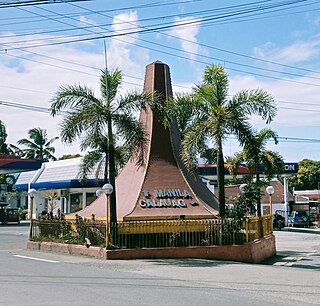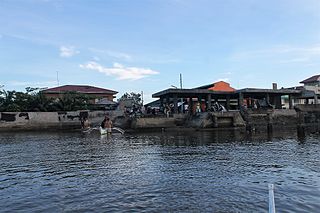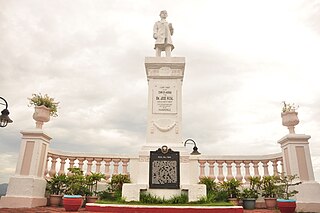This article has multiple issues. Please help improve it or discuss these issues on the talk page . (Learn how and when to remove these messages)
|
Lucena | |
|---|---|
| City of Lucena | |
Clockwise from top left: St. Ferdinand Cathedral, Tayabas Capitol (Quezon Provincial Capitol), Quezon Avenue, Quezon Monument, Lucena Diversion Road Underpass, Port of Lucena | |
| Motto: BOOM Lucena! | |
| Anthem: Ang Lungsod ng Lucena | |
 Map of Calabarzon with Lucena highlighted | |
Location within the Philippines | |
| Coordinates: 13°56′N121°37′E / 13.93°N 121.62°E | |
| Country | Philippines |
| Region | Calabarzon |
| Province | Quezon (geographically only) |
| District | 2nd district |
| Founded | November 3, 1879 [1] |
| Cityhood (de jure) | June 17, 1961 [2] |
| Cityhood (de facto) | August 20, 1961 [3] |
| Highly urbanized city | July 1, 1991 |
| Named for | Lucena, Córdoba, Spain |
| Barangays | 33 (see Barangays) |
| Government | |
| • Type | Sangguniang Panlungsod |
| • Mayor | Mark Don Victor B. Alcala |
| • Vice Mayor | Roderick A. Alcala |
| • Representative | David C. Suarez |
| • City Council | Members |
| • Electorate | 183,412 voters (2022) |
| Area | |
• Total | 80.21 km2 (30.97 sq mi) |
| Elevation | 61 m (200 ft) |
| Highest elevation | 1,687 m (5,535 ft) |
| Lowest elevation | 0 m (0 ft) |
| Population (2020 census) [5] | |
• Total | 278,924 |
| • Density | 3,500/km2 (9,000/sq mi) |
| • Households | 66,905 |
| Demonym | Lucenahin |
| Economy | |
| • Income class | First class, Highly Urbanized |
| • Poverty incidence | 6.40 % (2021) [6] |
| • Revenue | ₱ 1,853 million (2022) |
| • Assets | ₱ 3,359 million (2022) |
| • Expenditure | ₱ 1,745 million (2022) |
| • Liabilities | ₱ 1,377 million (2022) |
| Service provider | |
| • Electricity | Manila Electric Company (Meralco) |
| Time zone | UTC+8 (PST) |
| ZIP code | 4300, 4301 |
| PSGC | |
| IDD : area code | +63 (0)42 |
| Native languages | Tagalog |
| Website | lucenacity |
Lucena (IPA: [lʊˈsɛna] loo-SEH-nɘ), officially the City of Lucena (Filipino : Lungsod ng Lucena), is a highly urbanized city in the Calabarzon region of the Philippines. According to the 2020 census, it has a population of 278,924 people. [5]
Contents
- History
- Early history
- Filipino-American War
- World War II
- Cityhood
- Geography
- Barangays
- Climate
- Demographics
- Economy
- Retail and commerce
- Industries
- Places of interest
- Historical sites and tourist attractions
- Ancestral or heritage structures[28]
- Culture
- Festivals and celebrations
- Government
- Local government
- Elected officials
- List of former chief executives
- Infrastructure
- Transportation
- Communication
- Hospitals
- Education
- Notable personalities
- Sister cities
- References
- External links
It is the largest city and capital of Quezon Province wherein it is geographically situated and grouped under the province by the Philippine Statistics Authority, but in terms of government and administration, the city is politically independent from that province. It is one of the proposed metropolitan area in the Philippines. Metro Lucena is proposed to included the highly urbanized city of Lucena, as well as the towns of Candelaria, Dolores, Lucban, Pagbilao, Sampaloc, San Antonio, Sariaya, Tayabas and Tiaong.














































